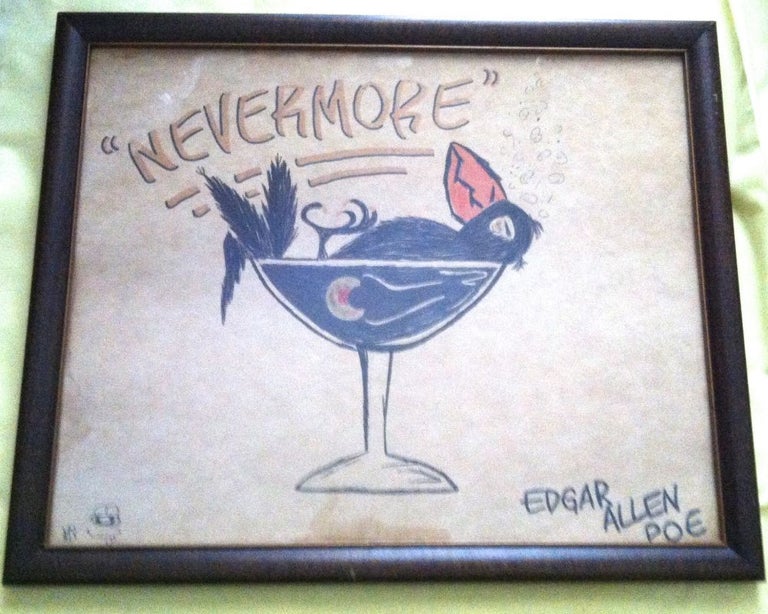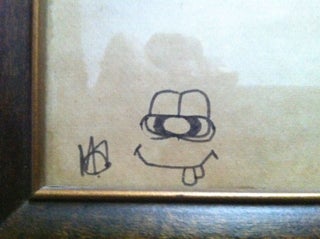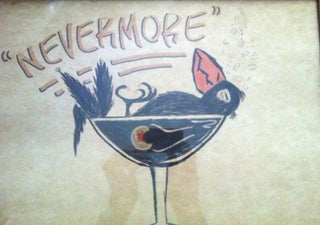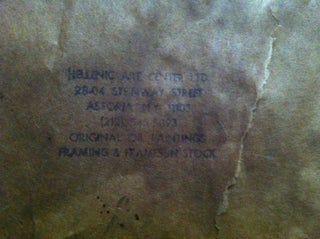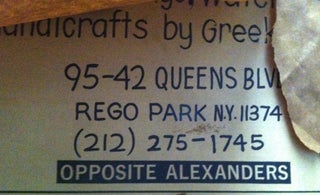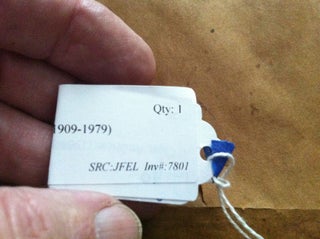"NEVERMORE"
New Jersey or New York? Al Capp, ca.1930's. Al Capp. UNIQUE. Framed. Oil painting framed (15 1/2" H by 18 5/8" W; image: 13 7/16" x 16 7/16") signed by Al Capp with facial caricature of a man with bulbous eyes & two teeth plus initials; with the Edgar Allen Poe-based caption "Nevermore" in gold with black highlighting and double underlining, above a cartoon of a drunken black raven with orange beak passed out upside down in a martini glass while still holding an olive with pimento.
On the tattered brown paper backing, there is the ink inscription: "PRESENT from MR. ACE" / The One and Only 1981" and an old browned newspaper cut-out of an Edgar Allen Poe caricature (see below).
Panel beneath the brown paper reads:
Visit our
Grecian Art Pavilion Ltd.
Home of the
"Hellenic Art Festival"
Exquisite Oil Paintings, Watercolors and
select Handicrafts by Greek Artists
95-42 Queens Blvd.
Rego Park N.Y. 11374
(212) 275-1745
Opposite Alexanders
with auction tag
Stamp (faded) on brown paper reads:
Hellenic Art Center, Ltd.
2804 Stenway Street
Astoria, N.Y. 1805
(210)-545-5093
Original Oil Paintings
Framing & Frames in Stock. Very Good. Item #177
"Nevermore" is Al Capp's amusing painted parody of Edgar Allen Poe's famous croaking Raven, adapted to point the negative moral of drunkenness for alcoholics. This remarkable and unique framed oil is in a somewhat worn wooden frame; executed on board (?); and signed with Capp's unusual early caricature face & initials.
Al Capp (1909-79) has been called--correctly, I believe--the "Mark Twain of cartoonists." Other comparisons have likenened his work to that of Charles Dickens, who also used social satire, lampoons, reformist topicality, and memorable names for his unforgettable characters. Thus, Capp observed that Dickens might have written comics if he had been alive today. As Capp also liked to emphasize: "No artist who can write should avoid words; no author who can draw should avoid drawing."
From his boyhood on, Al Capp was an enthusiastic reader of "literary classics" to name a few: adventure novels, Dickens, Thackeray, Conrad, Trollope, G.B. Shaw, and Edgar Allen Poe. During the late '40's and '50's, when public fears mounted about violence and horror in comics having negative effects on children, Capp used the example of Poe to illustrate that great authors and their works were not deemed to have such negatives. In this remarkable use of a major Poe image--that of the Raven who croaked "Nevermore"--Al only slightly twists it humorously to point a moral against alcoholism.
(Of course, Poe himself suffered from alcoholism . . . and more, while Capp was always a teetotaller, though he, too, suffered in later life from a "cocktail" of drugs he took to cope with manic-depressive tendencies and chronic pain caused by the early amputation of most of his right leg.)
No doubt, in part, because of the mysterious alchemy created by the interaction of his comedic genius with his physical and emotional problems, Capp's comic-based social satire was brilliant, inventive, frequently controversial, enormously influential, and topical--having persisted for 40 or more years through the middle of the 20th century with numerous repercussions to this day.
Capp's characters and related creations have become part of American folklore; among them, Dogpatch and its folksy denizens: Mammy and Pappy Yokum; Li'l Abner and a bevy of busty-and-leggy femmes fatals: Daisy Mae, Stupifying Jones, Wolf Gal, Lena the Hyena,, and Available Jones.
For many, the depressed region of "Slobbovia" still resonates. Capp's inventive genius led to other memorable creations such as "Sadie Hawkins' Day" (from 1937), and the mass merchandising of "Shmoos" (1948ff.), "Kigme's," and "Kickapoo Joy Juice." Several of Capp's memorable phrases have also entered everyday use such as "amoozin and confoozin," or during the Cold War, the name "Nogoodnik." Likewise, musicals and movies have been made of "Li'l Abner," while an Arkansas' theme park named "Dogpatch" opened in 1968.
A high school dropout, Al Caplin took a succession of art courses from several distinguished art schools before he invariably dropped out. Accordingly, his brilliant gifts as a cartoonist were honed on the job after constant practice.
Highly relevant to the dating of our oil "Nevermore," during Al Capp's school-and-early apprentice years, he sometimes worked in oils. Because this rare--but undated--cartoon has been executed in oils, we can delimit its creation to Capp's early creative years.
For a brief time, Capp was active as a boardwalk caricaturist around Asbery Park, New Jersey. At that time--about 1931-32--he hung out with an alcoholic portrait sketcher named Anderson. That Capp strongly rejected having a similarly depressed, tawdry, and boozy life as a starving artist suggests the milieu in which this memorable piece may have been created.
Instead, as a lifelong teetotaller, Al soon took his portfolio of drawings to New York City, where he began his strenuous climb toward recognition and prominence. Also about this time, though he was still signing his work as "A. G. Caplin" in the early 1930s, he formally changed his name to "Al Capp" after he turned 22 in early 1931. We can thus place the creation of this piece to around this period.
Comparison of Al Capp's signatures over his career--especially this caricature & initial--indicates that this example is from earlier in his career.
Most famous for "Li'l Abner," he began his famous strip on August 8, 1934, while his first full color Sunday strip came out on February 24, 1934. The beloved strip achieved an enormous circulation of 25-million by 1946. And between 1937 and 1947, it is estimated that each day about 70 million people read his "Li'l Abner" comic strip.
Artist-writer Capp often remarked: "I think of myself as a novelist and of 'Abner' as a novel, a page of which is pulled every day. At the end of the year, I've written 365 pages, fully illustrated."
The remarkable period of the Thirties also saw the birth of Chester Gould's "Dick Tracy" (1931) and "Terry and the Pirates" (1934); while "Superman" (Action Comics) came into being in 1938. Capp created the comic strip of "Abbie an' Slats" in 1937.
During World War II, because he had lost most of his right leg in a trolley-car accident, Capp was 4-F. He actively participated in creating promotions for war bonds, and regularly visited wounded vets for whom he regularly drew pictures. The tone of our piece doesn't seem appropriate, though, for a possible hospital visit.
During the war and through most of the later 1940's, however, Capp also created devastating pre-Mad magazine parodies. Among them, he lampooned Milt Caniff's "Steve Canyon" with his own "Milton Goniff's, 'Steve Cantor'"; John Steinbeck's, Grapes of Wrath (the Ford film of 1940); and his friend Chett Gould's "Dick Tracy" in contrast to Capp's ridiculous detective "Fearless Fosdick" (1942ff.). Al overstepped contemporary legal boundaries with a strip parody of "Gone wif the Wind" starring "Wreck Butler" and "Scallop O'Hara" in late 1942. As a result, Margaret Mitchell threatened to sue his publisher for $76-million, thereby causing Capp to drop the spoof and formally apologize in another cartoon.
Stylistically, our "Nevermore" is a take-off or parody of Poe's very well-known, ominous raven. During the early 1940s, several cartoonists created similar crows and ravens. Capp's raven resembles Chuck Jones' "Mynah bird" that he created for Warner Brothers from 1939-41. Likewise, Cliff Edwards' "Jim Crow" appeared in Disney's "Dumbo" in 1941. One also notes nose art that WWII pilots used to decorate their warbirds ("Old Crow Express" being one such); as well as Paul Terry's very popular, "Heckle & Jeckle"--actually two Magpies, not ravens--that he created in 1946 for Terrytoons. Because of this ravenesque flocking, I would put a terminus a quem date on Capp's fine piece of the mid-1940s.
The above date spread (circa 1929-1946) is reinforced by a survey of Al Capp's other bird sketches--not just ravens or crows. This, too, suggests that the simplicity and humor of his raven in "Nevermore" dates from an earlier phase of his long career. Examination of other birds--particularly parrots--indicates that his "bird-style" became more elaborate and decorative over time (e.g., "The Parrots of Wimpole Street" Oct. 1959 drawn by Capp &/or Frazee {lot 582 in Nate D. Sanders' 2013 catalog; a flamboyant and wildly colored parrot drawn by Capp in 1974 [lot 710 in Sanders]).
We thus provisionally date our Edgar Allen Poe parody to between the late 1920's through the mid-1940's; and cartoon styles he used--in keeping with other cartoonists--during the 1940's, as reflected by the cartoon of Capp's raven. Accordingly, "Nevermore" fits within the period late 1920's through the immediate post-WWII period, say, 1946.
The possible reverberation of Capp's antagonism to alcoholism (pronounced in 1931-32); his use of paint as medium (as during his student and impoverished apprentice days); coupled with the slight wear to the finish of the paint, however, suggest a date closer to the 1930's than the 1940's. We conjecture that this piece was possibly executed in New Jersey and taken with the cartoonist to New York as part of his portfolio in the early 1930's.
(One notes that Al Capp once again used oils near the end of his life, when he had an exhibition of large paintings of notable "Li'l Abner" characters at the New York Cultural Center {April 15-May 11, 1975}. At this time, neither the finish, subject, backing, nor size of our parody fit his late spurt of productivity in oils.)
The matter of dating is somewhat complicated by the brown paper backing writing, stamp, and framer's ad beneath it.
The brown paper backing of the painting has become tattered but one can still read "For MR. ACE / "The One and Only" as well as next to it the clear date "1981." Given the early suggested dates for the creation of Capp's artwork, we assume that this painting was given after Capp's death in 1979 to "Mr. ACE / The One and Only" whomever that was, in "1981."
Also, on the paper backing, there was previously a taped [& now removed for safe-keeping] small ~ 3" newspaper clippling depicting a caricature of Edgar Allen Poe with his famous raven [not by Capp] with a date of "1967" appearing on its verso. We cannot be certain who cut out this clipping, but the "1967" date provides a terminus after which the clipping was cut.
One can also identify the Greek framer (see above). Given the convergence of likely dates around the late 1920's/early 1930s-early 1940s, however, these later indications of framing suggest that the painting was gifted--perhaps more than once--sometime between 1967 and 1981.
(For additional references, see especially, a recent catalog of Al Capp cartoons issued by Nate D. Silver, Inc., in September, 2013; as well as Michael Schumacher & Denis Kitchen, Al Capp: A Life to the Contrary, Bloomsbury (2013)--especially pages 20 on Al's early reading; 34 on the alcoholic caricaturist Anderson; 81, 112-13, 136 on Poe; 162 on Stenbeck's plaudits; & pages 251-52: where Capp observed that when he took up oils in the 1970's, he hadn't used that medium since art school.).
Price: $1,450.00

